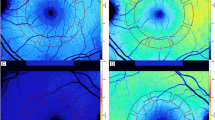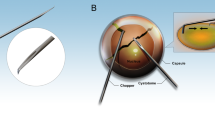Abstract
Purpose To evaluate the compression characteristics of the human lens nucleocortex in relation to its LOCSIII clinical grading.
Methods Sixteen subjects undergoing planned extracapsular cataract surgery had pre-operative slit-lamp examination and assessment of cataract LOCSIII grade followed by postoperative in vitro evaluation of the nucleus with measurement of ‘linear compressibility’ by a purpose-designed caliper incorporating a strain gauge, enabling the derivation of a graph of nuclear compression (D (mm) against applied force (F (N)).
Results Nuclear colour correlates with the force required to compress a lens to 75% of its original depth (F75) (R = 0.625, P = 0.017). Nuclear opalescence correlates with the force required to compress a lens to 75% of its original depth (R = 0.651, P = 0.012) and inversely with linear compressibility (ΔD/ΔF, the slope of the graph of nuclear compression against applied force) (R = −0.610, P = 0.014). F75 is a direct and linear compressibility is an inverse related parameter of lens nucleus ‘hardness’.
Conclusion A new instrument is described which allows measurement of ‘hardness’-related compression characteristics of the human cataract in vitro. There is a relationship between the LOCSIII clinical classification of nuclear cataracts and mechanical compression characteristics of the cataractous lens. LOCSIII classification may aid the preoperative planning of an appropriate surgical approach to an individual cataract.
Similar content being viewed by others
Log in or create a free account to read this content
Gain free access to this article, as well as selected content from this journal and more on nature.com
or
References
Desai P, Minassian DC, Reidy A . National cataract surgery survey 1977–8: a report of the results of the clinical outcomes. Br J Ophthalmol 1999; 83: 1336–1340
Czygan G, Hartung C . Mechanical testing of isolated senile human eye lens nuclei. Med Eng Phys 1996; 18: 345–349
Chylack LT Jr, Wolfe JK, Singer DM, Leske MC, Bullimore MA, Bailey IL et al. The Lens Opacities Classification System III. Arch Ophthalmol 1993; 111: 831–836
Thompson JR, Deane JS, Hall AB, Rosenthal AR . Associations between lens features assessed in the Oxford Clinical Cataract Classification and Grading System. Ophthalmic Epidemiol 1997; 4: 207–212
Heyworth P, Thompson GM, Tabandeh H, McGuigan S . The relationship between clinical classification of cataract and lens hardness. Eye 1993; 7: 726–730
Tabandeh H, Thompson GM, Heyworth P . Lens hardness in mature cataracts. Eye 1994; 8: 453–455
Gullapalli VK, Murthy PR, Murthy KR . Colour of the nucleus as a marker of nuclear hardness, diameter and central thickness. Ind J Ophthalmol 1995; 43: 181–184
Assia EI, Medan I, Rosner M . Correlation between clinical, physical and histopathological characteristics of the cataractous lens. Graefes Arch Clin Exp Ophthalmol 1997; 235: 745–748
Tabandeh H, Thompson GM, Heyworth P, Dorey S, Woods AJ, Lynch D . Water content, lens hardness and cataract appearance. Eye 1994; 8: 125–129
Pau H . The significance of brown coloration with regard to lens nuclear hardness in the case of extracapsular lens extraction. Ger J Ophthalmol 1992; 1: 139–141
Czygan G, Hartung C . On the correlation of mechanical and optical properties of cataractous eye lens nuclei. Biomed Tech 1997; 42: 2–6
Chylack LT Jr, Lesce MC, McCarthy D, Khu PM, Kashiwagi T, Sperduto R . Lens Opacities Classification System II. Arch Ophthalmol 1989; 107: 991–997
Karbassi M, Khu PM, Singer DM, Chylack LT Jr . Evaluation of lens opacities classification system III applied at the slitlamp. Optom Vis Sci 1993; 70: 923–928
Magno BV, Freidlin V, Datiles MB 3rd . Reproducibility of the NEI Scheimpflug Cataract Imaging System. Invest Ophthalmol Vis Sci 1994; 35: 3078–3084
Kashiwagi T, Khu PM . New method of measuring nuclear cataract in color Scheimpflug photographs. Ophthalmic Res 1990; 22 Suppl 1: 24–28
Khu PM, Kashiwagi T . Quantitating nuclear opacification in color Scheimpflug photographs. Invest Ophthalmol Vis Sci 1993; 34: 130–136
Sasaki K, Fujisawa K, Sakamoto Y . Quantitative evaluation of nuclear cataract using image analysis. Ophthalmic Res 1992; 24 Suppl 1: 26–31
Duncan DD, Shukla OB, West SK, Schein OD . New objective classification system for nuclear opacification. J Opt Soc Am A 1997; 14: 1197–1204
Garrett SK, Robman LD, McCarty CA, Thomas AP, McNeil JJ, Taylor HR . Reproducibility of automatic standard digital analysis of lens opacities. Aust NZ J Ophthalmol 1998; 26 Suppl 1: S29–S31
Robman LD, McCarty CA, Garrett SK, Stephenson H, Thomas AP, McNeil JJ, Taylor HR . Comparison of clinical and digital assessment of nuclear optical density. Ophthalmic Res 1999; 31: 119–126
Foo KP, Maclean H . Measured changes in cataract over six months: sensitivity of the Nidek EAS-1000. Ophthalmic Res 1996; 28 Suppl 2: 32–36
Panchapakesan J, Cumming RG, Mitchell P . Reproducibility of the Wisconsin cataract grading system in the Blue Mountains Eye Study. Ophthalmic Epidemiol 1997; 4: 119–126
Braccio L, Camparini M, Graziosi P, Baratta G, Ferrigno L, Williams SL et al. An independent evaluation of the Age-Related Eye Disease Study (AREDS) cataract grading system. Curr Eye Res 1998; 17: 53–59
Hall AB, Thompson JR, Deane JS, Rosenthal AR . LOCS III versus the Oxford Clinical Cataract Classification and Grading System for the assessment of nuclear, cortical and posterior subcapsular cataract. Ophthalmic Epidemiol 1997; 4: 179–194
Chylack LT Jr, Wolfe JK, Friend J, Khu PM, Singer DM, McCarthy D et al. Quantitating cataract and nuclear brunescence, the Harvard and LOCS systems. Optom Vis Sci 1993; 70: 886–895
Rouhiainen P, Rouhiainen H, Notkola IL, Salonen JT . Comparison of the lens opacities classification system II and Lensmeter 701. Am J Ophthalmol 1993; 116: 617–621
Taylor HR, Lee JA, Wang F, Munoz B . A comparison of two photographic systems for grading cataract. Invest Ophthalmol Vis Sci 1991; 32: 529–532
Bursell SE, Baker RS, Weiss JN, Haughton JF, Rand LI . Clinical photon correlation spectroscopy evaluation of human diabetic lenses. Exp Eye Res 1989; 49: 241–258
Ayaki M, Ohde H, Yokoyama N . Size of the lens nucleus separated by hydrodissection. Ophthalmic Surg Lasers 1993; 24: 492–493
Bhat KS, John A, Reddy PR, Reddy PS, Reddy VN . Effect of pigmentation on glutathione redox cycle antioxidant defense in whole as well as different regions of human cataractous lens [published erratum appears in Exp Eye Res 1992; 54: 317]. Exp Eye Res 1991; 52: 715–721
Mota MC, Ramalho JS, Carvalho P, Quadrado J, Baltar AS . Monitoring in vivo lens changes. A comparative study with biochemical analysis of protein aggregation. Doc Ophthalmol 1992; 82: 287–296
Matsuoka R, Watanabe M, Ueno H . [A study of coloring in human lens nucleus-association of four inorganic elements and dielectric behavior with nuclear color]. [Japanese] Nippon Ganka Gakkai Zasshi 1997; 101: 359–364
Jongebloed WL, Kalicharan D, Los LI, Worst JG . Study of the substructure of the Morgagni and Brunescens cataract with the TAO non-coating technique. Part 2: Brunescens cataract. Doc Ophthalmol 1992; 82: 161–168
Basti S . Different faces of the white cataract: a phaco surgeon’s perspective. Aust NZ J Ophthalmol 1999; 27: 53–56
Maraini G, Pasquini P, Sperduto RD, Bonacini M, Carrieri MP, Corona R et al. The effect of cataract severity and morphology on the reliability of the Lens Opacities Classification System II (LOCS II). Invest Ophthalmol Vis Sci 1991; 32: 2400–2403
Acknowledgements
The authors wish to thank Mr Don Ritchie, Mr Ron Clarke and Mr Ian Eversden for their technical support, Dr ALT Killingback for help with analyses, Professor JM Bland for statistical advice and Mr Irving K Luke for supplying nuclei.
Author information
Authors and Affiliations
Corresponding author
Additional information
Proprietary interest: None Presented as a poster at the Royal College of Ophthalmologists Annual Congress, Harrogate, May 2000
Rights and permissions
About this article
Cite this article
Smith, J., El-Brawany, M., Nassiri, D. et al. The relationship between nuclear colour and opalescence on the LOCSIII scale and physical characteristics of cataract nuclei. Eye 16, 543–551 (2002). https://doi.org/10.1038/sj.eye.6700119
Published:
Issue date:
DOI: https://doi.org/10.1038/sj.eye.6700119
Keywords
This article is cited by
-
Application of prechop technique in phacoemulsification for cataract patients with highly liquefied vitreous: a retrospective study
BMC Ophthalmology (2022)
-
Corneal endothelial function after phacoemulsification using the fluid-based system compared to conventional ultrasound technique
Eye (2007)
-
Stiffness gradient in the crystalline lens
Graefe's Archive for Clinical and Experimental Ophthalmology (2007)



